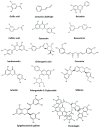Plant Polyphenols for Aging Health: Implication from Their Autophagy Modulating Properties in Age-Associated Diseases
- PMID: 34681206
- PMCID: PMC8538309
- DOI: 10.3390/ph14100982
Plant Polyphenols for Aging Health: Implication from Their Autophagy Modulating Properties in Age-Associated Diseases
Abstract
Polyphenols are a family of naturally occurring organic compounds, majorly present in fruits, vegetables, and cereals, characterised by multiple phenol units, including flavonoids, tannic acid, and ellagitannin. Some well-known polyphenols include resveratrol, quercetin, curcumin, epigallocatechin gallate, catechin, hesperetin, cyanidin, procyanidin, caffeic acid, and genistein. They can modulate different pathways inside the host, thereby inducing various health benefits. Autophagy is a conserved process that maintains cellular homeostasis by clearing the damaged cellular components and balancing cellular survival and overall health. Polyphenols could maintain autophagic equilibrium, thereby providing various health benefits in mediating neuroprotection and exhibiting anticancer and antidiabetic properties. They could limit brain damage by dismantling misfolded proteins and dysfunctional mitochondria, thereby activating autophagy and eliciting neuroprotection. An anticarcinogenic mechanism is stimulated by modulating canonical and non-canonical signalling pathways. Polyphenols could also decrease insulin resistance and inhibit loss of pancreatic islet β-cell mass and function from inducing antidiabetic activity. Polyphenols are usually included in the diet and may not cause significant side effects that could be effectively used to prevent and treat major diseases and ailments.
Keywords: autophagosome; caffeic acid; cancer; curcumin; diabetes; epigallocatechin gallate; luteolin; natural products; neurodegenerative disease; resveratrol.
Conflict of interest statement
The authors declare no conflict of interest.
Figures
References
Publication types
Grants and funding
LinkOut - more resources
Full Text Sources



